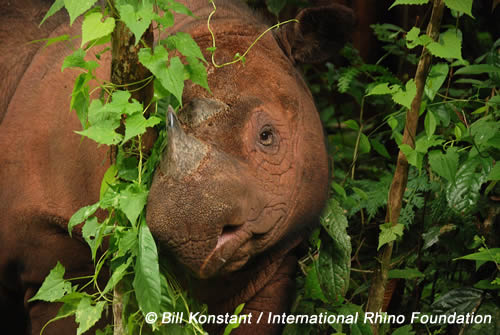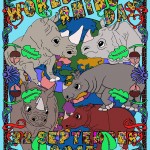President Susilo Bambang Yudhoyono of Indonesia has declared June 5th, 2012, as the beginning of the International Year of the Rhino.
It is a fitting proclamation, as Indonesia is home to the world’s rarest rhino species: Javan and Sumatran rhinos.
Both species are classified as Critically Endangered, with populations teetering at only around 40 Javan rhinos and fewer than 200 Sumatran rhinos.
Dr. Susie Ellis, Executive Director of the International Rhino Foundation, applauds President Yudhoyono’s announcement, noting that “unprecedented threats” are pushing Javan and Sumatran rhinos ever closer to extinction.
Sumatran and Javan rhinos are among the most threatened species on Earth. Unprecedented threats such as habitat loss and poaching have pushed these species, which have walked the Earth for more than 50 million years, towards a very real probability of extinction within our lifetime. We applaud President Yudhoyono for this call to action which we hope will help to ensure the survival of these magnificent animals for future generations.
CEO of WWF-Indonesia, Dr. Efransjah, says that his organization will support Year of the Rhino.
WWF offers its full support for the commitment made by Indonesia’s president to secure a future for the country’s critically endangered rhinos.
There is an urgent need to decrease pressures on habitats and to establish a second Javan rhino population in a safer and suitable location. This will be a big endeavor that will require true leadership from government and critical partnerships among scientists, conservation organizations and local communities.
According to Dr. Bibhab Kumar Talukdar, Chair of the IUCN SSC Asian Rhino Specialist Group, both Javan and Sumatran rhino numbers are decreasing.
The two rhinoceros species closest to extinction are the Javan and Sumatran Rhinos, numbering less than 50 and 200 animals respectively, with populations of both thought to be in decline. Rhinos have a significant and important role in the culture of many societies and the extinction of any rhino species is a loss to our cultural heritage as well as our planet’s biological diversity.
Hope for Sumatran and Javan rhinos
Thanks to the efforts at the Sumatran Rhino Sanctuary, there is hope that the Sumatran rhino population may be increasing, as Ratu’s baby is expected to arrive soon.
Update: On July 23rd, 2012, Ratu gave birth to a healthy male calf, who has been named “Andatu” – learn more here.
The baby’s father is world-famous Andalas, who was born at the Cincinnati Zoo, and later moved to the 250-acre Sumatran Rhino Sanctuary in 2007, where he resides with Ratu and two other females, Rosa and Bina.
Javan rhino calves have also been documented in Indonesia.
Earlier this year, park authorities at Indonesia’s Ujung Kulon National Park compiled this amazing video footage which documents more than 30 Javan rhinos — almost the entire population in just 10 minutes and 27 seconds:
The International Rhino Foundation and WWF are providing an additional 140 camera traps to more closely monitor Javan rhinos in Ujung Kulon National Park.
The International Rhino Foundation, through its on-the-ground partner, the Rhino Foundation of Indonesia, supports Rhino Protection Units that safeguard the last remaining populations of Javan and Sumatran rhinos.
Law enforcement must be ‘scaled up’
In South Africa, at least 227 rhinos have been killed for their horns this year, as of May 28th.
While South Africa has made a number of rhino crime-related arrests (148 as of May 28th), the convictions seem to be few and far between — and no “kingpins” have been nabbed.
Many of the cases indicate the direct involvement of corrupt members of South Africa’s private wildlife industry.
Dr. Tom Milliken of the wildlife trade monitoring group TRAFFIC recommends that South Africa “scale up” its law enforcement efforts, in conjunction with demand reduction in consumer markets.
It is critical that Africa’s law enforcement efforts are significantly scaled up and linked with enforcement and demand reduction efforts in consumer markets in Asia. We’ll only win this war if both sides align against the criminal syndicates behind this trade.
“Concerted efforts” are necessary, says Dr. Susie Ellis of IRF.
There must be concerted efforts among governments of range and consumer countries, such as Vietnam and China, to enforce laws and international treaties in order to stem this tide.
But the rhino crisis is not confined to the conservation community.
Rhino horn, ivory trade linked to global insecurity
The rhino horn and ivory trade have reached such horrifying heights that the matter was the topic at the recent U.S. Senate Committee on Foreign Relations Hearing.
Testimony regarding the clear connection between global insecurity and the surging illegal ivory and rhino horn trafficking was heard by Senator John Kerry. Witnesses included Dr. Iain Douglas-Hamilton (Founder, Save the Elephants), John Scanlon (Secretary-General of CITES), and Tom Cardamone (Managing Director, Global Financial Integrity).
It was noted that due to its high value and low risk, wildlife trafficking — such as ivory and rhino horn — has become a vehicle for funding insurgent groups, terrorism, and drug cartels. (Despite this, there is an ongoing agenda in South Africa in favor of a “legalized” rhino horn trade.)
The value of wildlife crime is estimated at between $7.8 and $10 billion dollars annually.
Two rhino subspecies confirmed extinct in 2011
Sadly, 2011 was a devastating year for the world’s rhinos.
Two subspecies of rhino — one Asian and one African — were confirmed extinct: The Vietnamese Javan rhino (Rhinoceros sondaicus annamiticus) and the Western black rhino (Diceros bicornis longipes).
Another subspecies, the Northern white rhino (Ceratotherium simum cottoni), clings to existence with just seven surviving individuals. However, there is hope, as Suni and Najin (two of the seven) demonstrate in the video below:
Here’s to hoping for a safe and secure future for all five rhino species in this International year of the Rhino!






